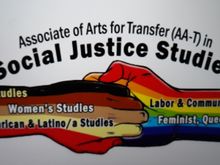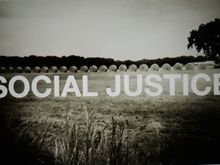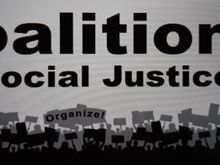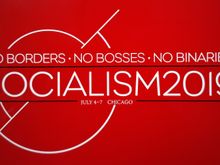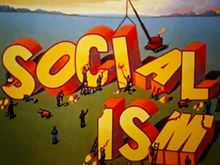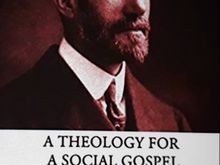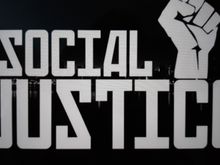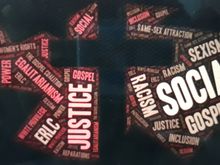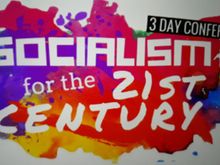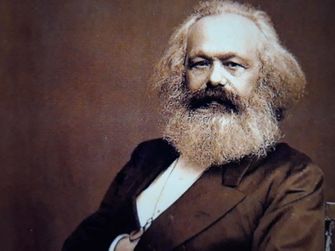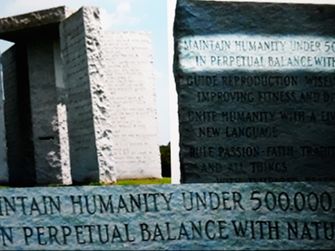Painting A Bigger Picture
Social Change
Collective behavior and social movements are just two of the forces driving social change, which is the change in society created through social movements as well as external factors like environmental shifts or technological innovations. Essentially, any disruptive shift in the status quo, be it intentional or random, human-caused or natural, can lead to social change. Below are some of the likely causes.
Causes of Social Change
Changes to technology, social institutions, population, and the environment, alone or in some combination, create change. Below, we will discuss how these act as agents of social change, and we’ll examine real-world examples. We will focus on four agents of change that social scientists recognize: technology, social institutions, population, and the environment.
https://courses.lumenlearning.com/sociology/chapter/social-change/
Definition
“Positive social change” refers to involvement in activities that improve the lives of individuals and communities locally and around the world. In other words, a social change agent can include anyone who Gives, Advocates or Volunteers
https://www.unitedway.org/blog/what-kind-of-social-change-agent-are-you
Humanity: An Agent of Global Environmental Change
https://www.nap.edu/catalog/1435/one-earth-one-future-our-changing-global-environment
Social Agents of Change
Globalizing my Curriculum to Create Future Globalized Thinkers and Leaders
Social Justice
Social Justice Studies
Social Gospel
The Social Gospel of the Past
The Social Agenda of Today
Socialism
Socialism’s Empty Promises: Is Socialism The Answer if You Want To Help People?
Definition of Socialism
so·cial·ism
/ˈsōSHəˌlizəm/
noun
a political and economic theory of social organization which advocates that the means of production, distribution, and exchange should be owned or regulated by the community as a whole.
synonyms: leftism, Fabianism, syndicalism, consumer socialism, utopian socialism, welfarism; More
policy or practice based on the political and economic theory of socialism.
synonyms: leftism, Fabianism, syndicalism, consumer socialism, utopian socialism, welfarism; More
(in Marxist theory) a transitional social state between the overthrow of capitalism and the realization of Communism.
Socialism
In a socialist economy, the state owns and controls the major means of production. In some socialist economic models, worker cooperatives have primacy over production. Other socialist economic models allow individual ownership of enterprise and property, albeit with high taxes and stringent government controls.
The primary concern of the socialist model, in contrast, is an equitable redistribution of wealth and resources from the rich to the poor, out of fairness and to ensure "an even playing field" in opportunity and outcome. To achieve this, the state intervenes in the labor market. In fact, in a socialist economy, the state is the primary employer. During times of economic hardship, the socialist state can order hiring, so there is full employment even if workers are not performing tasks that are particularly in demand from the market.
https://www.investopedia.com/ask/answers/020915/what-are-differences-between-capitalism-and-socialism.asp
What Is Social Justice?
Mar 29, 2019 · Social justice is a political and philosophical concept which holds that all people should have equal access to wealth, health, well-being, justice, and opportunity.
Understanding Social Justice
Social justice is a broad concept that is not limited to any specific religious or political movement. It is generally associated with the political left, and in the U.S. its advocates are found mainly in the Democratic party, particularly in the party's self-identified progressive and socialist wings. Progressives and socialists who do not associate with the Democratic party (independents, Greens and others) also commonly employ the term.
Every major religion contains at least one social justice movement: liberation theology, a movement that originated among Latin American Catholics, is one of the most famous.
Self-identified advocates of social justice are often at odds with one another over specific policies and priorities, but share a broad vision of an ideal society in which no one race, class, religion, sexual orientation, gender identity, or language group is singled out for oppression or enjoys special privileges.
https://www.investopedia.com/terms/s/social-justice.asp
Definition
Pope Francis, the first Jesuit to hold the position, comes from an order of priests known around the world as educators and social justice advocates.
https://www.usatoday.com/story/news/world/2013/03/13/jesuits-order-education-social-justice/1986081/
Agents of Change
Choose Peace Clubs
Social Justice
Coalition for Social Justice
Social Gospel
Embracing the Spirit of the Age
Socialism
Conference in Chicago
Social Justice (Socialism)
Along with equality, social justice is one of the fundamental tenants of socialism. In terms of a basic definition, social justice seeks to ensure the best possible allocation of resources based upon a subjective judgement as to what is considered fair.
The concept of social justice assigns certain responsibilities towards the various institutions of society (such as the government, social security and public services). All socialists believe that the state can be used to create a more egalitarian society than that which exists under capitalism.
When socialists speak of social justice, it should be placed in the context of a more even distribution of wealth and opportunities. The redistribution of wealth within society ensures fair shares for all. An equitable distribution of wealth is therefore axiomatic with the goal of social justice. However, the extent to which the state and other institutions should intervene within the economy differs considerably within the various strands of socialist thought. Those closer to the centre-left of the political spectrum believe that social justice is achievable via a mixed economy with a significant role for both the public and private sector. In contrast, those further to the left believe in a greater role for the state whereas Marxists advocate common ownership to meet everyone’s needs. The key difference between the various strands of socialism centres upon the means to achieve socialism.
https://www.tutor2u.net/politics/reference/social-justice-socialism
Socialism and the Battle Cry of Social Justice
https://www.aier.org/article/socialism-and-battle-cry-social-justice
A Theology for the Social Gospel
2010 Reprint of 1918 Edition. The Social Gospel movement was a Protestant Christian intellectual movement that was most prominent in the late 19th century and early 20th century. The movement applied Christian ethics to social problems, especially social justice, inequality, liquor, crime, racial tensions, slums, bad hygiene, child labor, weak labor unions, poor schools, and the danger of war. Theologically, the Social Gospel leaders were overwhelmingly post-millennialist in the sense that they believed the Second Coming could not happen until humankind had rid itself of social evils by human effort. Social Gospel leaders were predominantly associated with the Progressive Movement and most were theologically liberal, although they were typically more conservative when it came to their views on social issues. Walter Rauschenbusch was one of the leaders of this important Christian movement.
https://www.amazon.com/Theology-Social-Gospel-Walter-Rauschenbusch/dp/1891396528
Definition
A religious movement that arose in the United States in the late nineteenth century with the goal of making the Christian churches more responsive to social problems, such as poverty and prostitution. Leaders of the movement argued that Jesus' message was as much about social reform as about individual approaches to salvation (see also salvation).
https://www.dictionary.com/browse/social-gospel
Promote Social Change
How Teachers Can Promote Social Change in the Classroom
Social Justice
What’s wrong with the recent evangelical “social justice” movements?
Social Gospel
Social Gospel Terminology
Socialism
America, Socialism Is Actually Nothing to Be Afraid Of?
What Is Socialism for the Twenty-First Century?
For Chávez, the road was protagonistic democracy, protagonistic democracy in the workplace and community as the practice which transforms people. However, it is essential to grasp that this is not a reinvention. Rather, socialism for the twenty-first century is a revolutionary restoration—the return to Marx’s understanding of socialism. This renewed vision (as reflected in the “elementary triangle of socialism”) once again puts human development, the full development of human potential at the centre. It insists that:
(1) Everyone has the right to share in the social heritage of human beings—an equal right to the use and benefits of the products of the social brain and the social hand—in order to be able to develop his or her full potential.
(2) Everyone has the right to be able to develop his and her full potential and capacities through democracy, participation, and protagonism in the workplace and society—a process in which these subjects of activity have the precondition of the health and education that permit them to make full use of this opportunity.
(3) Everyone has the right to live in a society in which human beings and nature can be nurtured—a society in which we can develop our full potential in communities based upon cooperation and solidarity.
That renewed vision is desperately needed now because it can once again move people to struggle against capitalism and to “reclaim socialism as a thesis, a project, and a path.”
https://monthlyreview.org/2016/10/01/what-is-socialism-for-the-twenty-first-century/
Social Gospel, Social Justice & Christian Socialism
Social Gospel
The Social Gospel refers to the emphasis of a primarily Protestant movement in the late 19th century and early 20th century, to apply Christian principles to social problems.
Being part of the "modernism" trend with a strong emphasis on social justice, the movement is a rival to evangelical and fundamentalist Christianity. Members of the movement see it as a return to the beginning of Christianity, that is to the message of Jesus.
In the United States, prior to World War I, the Social Gospel was the religious wing of the progressive movement which had the aim of combating injustice, suffering, and poverty in society. In this context, it is seen as having provided the philosophical underpinning for the New Deal. After the war, the movement shifted its focus to the civil rights arena, and later, became outspoken in its opposition to the Vietnam War.
With the ascendancy of the "Christian right" beginning in the 1980s, the Social Gospel agenda declined in the United States, but examples of its continued existence can still be found, notably the organization known as the Call to Renewal.
Sometimes seen as a branch of Christian socialism, the Social Gospel movement was especially influential in Canada and led many ministers to become active in the socialist movement in the form of the Cooperative Commonwealth Federation and later the New Democratic Party. It was reflected in the novel In His Steps that was written by the Congregational minister Charles Sheldon, who coined the motto "What would Jesus do?" Sheldon was committed to Christian Socialism and identified with the Social Gospel. One of the early theologians of the Social Gospel was Walter Rauschenbusch, and he indicated how Sheldon's novel inspired his theology. Social Gospel is still influential in Canada's United Church and in the Anglican Church but has less influence in the United States. It also remains influential among Christian socialist circles in Britain in the Church of England, Methodist, and some Calvinist movements.
Both Catholicism and Liberation theology both have similarities to the Social Gospel. In the Anglican Church, the Social Gospel has found expression in pacifism.
https://www.theopedia.com/social-gospel
The Social Gospel
The rapid growth of urban-industrial society in the late nineteenth century forced Christians to find new ways to express their social ideals in the face of overcrowded cities and the emergence of vast inequities in access to services, power, and wealth. As a result, a “social gospel” emerged in the Protestant mainstream in the early twentieth century. While theological conservatives drew upon traditions associated with revivalism, which tended to emphasize the moral reform of individuals, theological liberals called for a reconstruction of the social order itself. They insisted that Christians needed to address directly, and in Christian terms, the new realities of urban industrial life. Confident and optimistic, liberals found an articulate voice in Walter Rauschenbusch, a Baptist who had worked with the poor in the area called Hell’s Kitchen in New York City. He transformed the biblical idea of the kingdom of God into a vision of the progressive Christian transformation of America into a cooperative Christian society. The social gospel became the driving vision of the Protestant mainstream in the decades preceding the First World War.
The war destroyed the confident optimism of this period, but in the 1930s, many Protestants found in Reinhold Niebuhr another powerful voice for a Christianity oriented toward social and ethical issues. As an urban pastor in Detroit, Niebuhr combined an interest in rigorous theology with a realistic approach to social justice and ethics. Together with his brother H. Richard Niebuhr, he championed a Christian social vision, known as neo-orthodoxy (though Niebuhr himself loathed the word), that inspired many Protestants into the 1950s. While there had been a Federal Council of Churches since 1908, the new National Council of Churches, formed in 1951, became an important instrument through which mainline churches could articulate a common theological and social vision in a rapidly changing America.
Social Christianity also found expression in the Catholic community. Many Catholic immigrants took part in the tumultuous labor movements of the nineteenth century. A formal framework for Catholic social thought and action was articulated by Pope Leo XIII in 1891 in the encyclical Rerum Novarum. This set Catholics on a course between socialism and capitalism by emphasizing the natural right to property, the justice of a fair wage, and the mediating role of the state. This approach dovetailed with the social policies of the New Deal years and remained central to Catholic social teachings until the Second Vatican Council of the early 1960s. Many of these themes remained part of the teaching of the American Catholic leadership, although by the late twentieth century other issues, such as opposition to abortion, gay marriage, and women’s ordination, received more attention.
The turbulent 1960s were marked by a resurgence of social Christianity that took many forms. The civil rights movement, under the leadership of the Rev. Dr. Martin Luther King, Jr. and other African-American clergy, was a classic restatement of the Protestant social gospel in its insistence that the religious ideal of justice be embodied in the institutions of society. Christian churches were active in the movement for racial and economic justice. Liberation theologies, which originated among progressive Catholics in Latin America, articulated the gospel anew from the perspective of those who experience racial, political, and economic oppression. Many women began to work out feminist theologies, beginning with the voices and experiences of women who had been marginalized in both church and society. Evangelical Christians also developed a strong voice on social issues, articulated in publications like Sojourners magazine.
After the death of King, who, by the time of his assassination in 1968 had turned his attention to the Vietnam War and other issues of social justice, popular reaction to war protests, black militancy, the “counterculture,” and other issues provoked a reaction from many laity in the “mainline” denominations, who believed that their leadership had become too strongly aligned with liberal and radical causes. The emergence of the Religious Right in the 1970s reframed Protestant involvement in social issues from a traditionalist direction. Most mainline Protestant denominations, however, as well as many lay Catholics, remained committed to social witness in the form of environmentalism, feminism, and gay rights.
http://pluralism.org/religions/christianity/christianity-in-america/the-social-gospel/
Karl Marx And The Communist Manifesto
Your Guide To Karl Marx And The Communist Manifesto - History Extra
Your guide to Karl Marx: who was he, what was the Communist Manifesto and why is he important?
The influential communist thinker Karl Marx, who died on 14 March 1883, was a German economist, sociologist and philosopher. Here, Gregory Claeys, the author of Marx and Marxism, brings you the facts about Karl Marx’s life, death, his theory and his legacy, and explains how, perhaps surprisingly, Marx remained a democrat throughout his life
Who was Karl Marx?
Karl Marx was a German economist, sociologist and philosopher. He was born on 5 May 1818 in Trier – which was then part of the Prussian Rhineland – and died in London on 14 March 1883.
Marx became interested in communism – the theory that the means of production ought to be owned in common and managed for the public good – after starting a career as a radical journalist in the early 1840s. He proceeded to become the foremost advocate of communism in 19th-century Europe and became famous chiefly through his association with the Paris Commune (1871) – a socialist working-class uprising against the French government that lasted two months.
After the continental revolutions of 1848 – a series of republican revolts against European monarchies, in Sicily, France, Germany, Italy and the Austrian Empire – Marx was forced into exile as a result of his political beliefs. He moved to London (where he would remain for the rest of his life) and spent much of his time studying in the British Museum Reading Room. He lived in relative obscurity and, for many years, considerable poverty, subsisting chiefly on regular contributions from his life-long intellectual partner, Friedrich Engels, who was employed at his father’s cotton-spinning factory in Manchester.
Marx’s best-known work is the Communist Manifesto (1848), which he wrote with Engels. The work predicts the final overthrow of the capitalist system, detailing how workers will one day rise up to seize the means of production. However, Marx’s most impressive study is arguably Capital (1867), which explores the origins, development and inner workings of the capitalist system
What did Karl Marx believe?
To understand the basics of Marx’s beliefs, it is important to recognise what was going on in Europe during the 19th century. During this period a new factory system was introduced that increasingly concentrated the workforce (the “industrial proletariat”) into poorly-paid, dangerous and unhealthy conditions. Poverty was rife in the new urban slums.
Marx believed that as more and more workers were pushed down into poverty, they would eventually rise up against their bosses. Socialist propagandists would then convince the workforce that production for human need (rather than profit) was preferable. They would persuade the proletariat to try to overthrow the system, Marx thought.
After this imagined revolution – which Marx in his early years assumed would be violent – a phase termed the “dictatorship of the proletariat” would ensue, in which an elected, working-class government would begin to manage the economy. The means of production, banks, transportation and land would all become publicly owned, and a central plan would be devised to ensure that the goods produced matched the needs of the population.
After a lengthy period of development – which would perhaps last for generations – the “state” would cease to exist as an alien organisation possessing a will and interest separate from that of the general population. Eventually a “communist society” would be achieved, in which most forms of coercion and exploitation (such as using the labour of others without fair reward) would end.
How did Karl Marx develop his ideas?
Marx built on the analyses of a number of earlier socialist writers – most notably Robert Owen, Charles Fourier and Henri de Saint-Simon – who had from around 1815 onwards contended that capitalism needed to be replaced by a system based on common ownership and/or management. By 1845 Marx became convinced that capitalism – that is, an economic and political system based on competition in the market and increasing technological advancement – was vulnerable to a process of recurring cyclical crises, in which wealth became increasingly concentrated in the hands of the few.
Many of Karl Marx’s chief writings were not published during his lifetime. Contemporary readers often begin with two of his works: the Paris Manuscripts of 1844, and the German Ideology of 1845-6 – both of which were only released in full in 1932 by researchers in the Soviet Union and were not widely discussed until the 1960s. The fact that neither of these two early works were published by Marx raises questions about whether he regarded their formulations as inadequate or immature. He developed themes from both, however, in later works.
In the Paris Manuscripts of 1844, Marx describes the “alienation” of the worker from the process of production; from his or her own product; from other workers; and from “species being” – a communal self-consciousness that provides the basis of sociability. He also theorises that dividing labour into minute, repetitive tasks prevents workers from achieving an “all-round” development of their intellectual capabilities. This, Marx claims, drives workers apart from one another by making them competitors, therefore undermining the natural solidarity of “species being”.
In the German Ideology, Marx appears to abandon the concept of “species being” in favour of a more historical account of capitalism as the latest “mode of production”. He also now saw the solidarity that workers achieved through their collaboration at work. This, he thought, was evidence of the sociability that would foreshadow a new society. At this stage, Marx saw capitalism as playing a largely progressive role in eradicating feudalism [the dominant social system in medieval Europe], and raising the prospect of popular sovereignty, though limited by bourgeois rule.
In later years, Marx shifted away from the possibility of eliminating “alienation” and moved towards the view that increasing mechanisation [the rise of work involving machinery] would offer much more free time for the working classes. However, as in 1844, he regarded the ‘mutilated’ personality of workers as being as a key result of capitalism. “They mutilate the labourer into a fragment of a man, degrade him to the level of an appendage of a machine,” he wrote in Capital (1867).
How responsible was Karl Marx for the spread of communism, including the rise of Stalinism, during the 20th century?
There were many varieties of Marxism on offer by the early 20th century, the most prominent of which was associated with the leading working-class party in Europe, the Social Democrats Party (SPD) in Germany. These so-called “revisionists” – notably Eduard Bernstein of the SPD – disagreed with much of what Karl Marx had proposed, including the notion that capitalism would produce a final great revolutionary catastrophe. Instead, the SPD thought, the system might be reformed gradually and peacefully through the ballot.
In Russia, meanwhile, the Bolshevik Revolution of 1917 insisted on a revolutionary interpretation of Marx’s ideas. The Bolsheviks were a tiny party in Russia led by Vladimir Lenin, whose goal was to overthrow the Provisional Government and set up a government for the proletariat (workforce). Lenin insisted that a dedicated conspiratorial group could attain political power. But in order to maintain it, authority would need to remain within the hands of a small group within the party, and then possibly even in the hands of one dictator.
Marx himself had never endorsed such a strategy – he remained a democrat throughout his life, insisting that leaders should be elected, recallable, and paid no more than an average worker’s wage. Despite this, Lenin claimed that his system was still democratic, naming it “democratic centralism” to indicate that decision-making involved consulting the masses, but thereafter flowed from the top down.
After Lenin’s death in 1924, Josef Stalin rose quickly to power. During the 1930s, while holding the position of secretary-general of the Communist Party of the Soviet Union, Stalin set about purging Russia of anyone he considered a threat. More than 750,000 people were murdered and many millions more were incarcerated under the Gulag’s forced labour prison system. The total number of those who died is not known, but it is thought it may have exceeded 20 million.
Many more died in China after Mao Tzedong’s revolution of 1949, including as many as 46 million during the ‘Great Leap Forward’ (1958-61), which was an attempt to create a vast decentralised industrial programme based on steel production.
Marx’s theories can be held at least partly accountable for some of these disasters, but not for ‘totalitarian dictatorship’ as such.
What makes Karl Marx important or relevant today?
Marx was, as much as anything else, a prophet and visionary who gave hope to millions that a life of endless, exhausting, exploited toil was not the inevitable lot of most of humanity. He was essentially a utopian thinker (though he disliked the term) who posited the ideal of a future good life, and then demanded that humanity seek this end.
Today, Karl Marx remains the most prominent of all modern thinkers to suggest that capitalism is a historically-limited phase of development, and to contend that a vastly more humane system of production and distribution might replace it. Despite the shortcomings noted above, Marx is a focal point for current discussions about humanity’s future development.
The greatest problem facing humanity this century is arguably environmental collapse. Here, curiously, Marx has perhaps failed to see that a proletarian revolution might give rise to a bourgeois one, where the workers come to define themselves as consumers. Marx envisioned a communist system in which high levels of industrial production would ensure a good standard of living for the entire population. His theory did not account for the issues of scarcity of resources and overpopulation; indeed they were not relevant to his epoch. However, what Marx did shrewdly observe was that those who profit from the existing system would resist any fundamental change to it – even if it jeopardised the lives of future generations to come. The rationale of capitalism lies in the maximisation of profit: no other ends can modify this aim. But the survival of humanity, Marx realised, clearly indicates that other strategies must be adopted if we are to avoid the worst form of dystopian future. Here Marx offers, if not comfort, at least inspiration.
Gregory Claeys is Professor of the History of Political Thought at Royal Holloway, University of London. He is the author of Marx and Marxism (Penguin Books, 2018).
This article was first published by History Extra in May 2018
https://www.historyextra.com/period/victorian/your-guide-to-karl-marx-who-was-he-what-was-the-communist-manifesto-and-why-is-he-important/
Definition of Marxism
: the political, economic, and social principles and policies advocated by Marx
especially : a theory and practice of socialism (see SOCIALISM sense 3) including the labor theory of value, dialectical materialism, the class struggle, and dictatorship of the proletariat until the establishment of a classless society
https://www.merriam-webster.com/dictionary/Marxism
Georgia Guide Stones & the Ten Commandments
The Georgia Guide Stones and the Ten Commandments of the Coming Antichrist
The Georgia Guidestones is a granite monument erected in 1980 in Elbert County, Georgia, in the United States. A set of ten guidelines is inscribed on the structure in eight modern languages, and a shorter message is inscribed at the top of the structure in four ancient language scripts: Babylonian, Classical Greek, Sanskrit, and Egyptian hieroglyphs.
The monument stands at the highest point in Elbert County, about 90 miles (140 km) east of Atlanta, 45 miles (72 km) from Athens, and 9 miles (14 km) north of the center of Elberton. The stones are visible from Georgia Highway 77 (Hartwell Highway) and are reached by turning east on Guidestones Road. The structure is sometimes referred to as an “American Stonehenge”. The monument is 19 feet 3 inches (5.87 m) tall, made from six granite slabs weighing 237,746 pounds (107,840 kg) in all. One slab stands in the center, with four arranged around it. A capstone lies on top of the five slabs, which are astronomically aligned. An additional stone tablet, which is set in the ground a short distance to the west of the structure, provides some notes on the history and purpose of the Guidestones.”
Guide Stones Ten Commandments of Antichrist (Satan)
• Maintain humanity under 500,000,000 in perpetual balance with nature.
• Guide reproduction wisely — improving fitness and diversity.
• Unite humanity with a living new language.
• Rule passion — faith — tradition — and all things with tempered reason.
• Protect people and nations with fair laws and just courts.
• Let all nations rule internally resolving external disputes in a world court.
• Avoid petty laws and useless officials.
• Balance personal rights with social duties.
• Prize truth — beauty — love — seeking harmony with the infinite.
• Be not a cancer on the earth — Leave room for nature — Leave room for nature.
Shall we go through the “commandments” one by one?
Maintain humanity under 500,000,000 in perpetual balance with nature.
This clearly states that the population on the earth should be maintained at 500 million people to be in “perpetual balance with nature.” Can they get anymore into New Age terminology than that?
I checked the number of people as of 2018 who inhabit the earth. 7.6 BILLION people live on the earth at this time.
Shall we do the math? Well, to put it in its simplest form – the NWO must rid our planet of almost 94% of all people to bring the population to its goal of 500 million.
One must ponder as to how to reduce the number of people on the earth by 94%. Bill Gates is doing his part by sending vaccines to third world countries which sterilizes young women. India got wise to this madman and analyzed the vaccines after many of their young women fell ill, while many others died.
India has a lawsuit against the Bill and Melinda Gates Foundation, but I seriously doubt whether this will ever be brought to trial.
Guide reproduction wisely — improving fitness and diversity.
We can discern that this commandment is related to Abortion. In the last 40 years, since Roe Vs Wade was passed, it is estimated that almost 2 billion abortions have been performed worldwide.
Over 60 million abortions have happened in the U.S. since 1973. But we can see that these figures merely put a small dent in the desired reduction of people on the planet.
Unite humanity with a living new language.
Interesting. Remember when God divided the language when Nimrod led the people in their attempt to build the Tower of Babel? Evidently, they were speaking ONE language, but the Lord put a stop to that. Now, humanity seeks to be united with a new “Living” language.
Rule passion — faith — tradition — and all things with tempered reason.
To be an obedient “Globalist” one must put aside individual passions; temper their faith, and let traditions die. After all, the globalists dream of that “Kumbaya” moment when everything is about the NWO – not the individual. And, of course, “Faith” will be the One World Religion.
Protect people and nations with fair laws and just courts.
Remember – the words “fair” and “just” will be defined by the One World Government.
Let all nations rule internally resolving external disputes in a world court.
Again – Ultimately, the One World Government (World Court) will have the final say for all nations – they will no longer be autonomous.
Avoid petty laws and useless officials.
I believe that this commandment is stating that anything that does not directly impact the NWO is petty and not worth their time.
Balance personal rights with social duties.
People must understand that under the One World Government, individuals must desire to be good globalist citizens and not demand personal rights.
Prize truth — beauty — love — seeking harmony with the infinite.
NEW AGE NEW AGE NEW AGE! Harmony with the infinite! As Christians, we clearly see that our love and devotion to Jesus Christ is in direct opposition to “seeking harmony with the infinite.”
Be not a cancer on the earth — Leave room for nature — Leave room for nature
Well, brethren – this certainly puts people in their place. Instead of being made in the image of God (which we know is true) we are clutter and even a “cancer” upon the earth – the Globalists would say “MOTHER EARTH.”
Going back to the permissible number of people being 500 million is still problematic. There HAS to be a catastrophic event or event(s) which wipe out most of humanity. And since this was engraved into the Georgia Guide Stones by individuals who must be involved with coming world events, I believe that these people are privy to what will happen. I also believe that they are satanists waiting for Antichrist. But they would not call him that name. To them, he is a savior of the earth. They are so totally deluded.
Warnings from Bill Gates
I have been reading warnings from Bill Gates that we are to brace for events such as the major flu pandemics which could easily wipe out 30 million people or more. In my research of this mad scientist, I truly believe that if these “pandemics” come to fruition, that Bill Gates will be directly involved.
Some might say that this is being a bit sensational. If you have the time, go to my WordPress and put in the search box “Bill Gates.” You will be shocked with the documented evidence that this man’s life’s work is to aid in population control.
Bill Gates’ father was a Eugenicist and at one point was the head of Planned Parenthood. Gates is following in his father’s footsteps.
I do not know the time frame for the Georgia Guide Stones NWO mandates. I do not believe that we will be here for this.
I believe that our Blessed Savior could come for us at any moment!
Keep looking up!
How Can I Be Saved?
Shalom b’Yeshua
MARANATHA!
https://grandmageri422.me/2018/07/22/the-georgia-guide-stones-population-control-and-the-coming-antichrist/
It’s A Matter Of Time Revelation 17 & 18 NKJV
Revelation 1
Introduction and Benediction
1 The Revelation of Jesus Christ, which God gave Him to show His servants—things which must shortly take place. And He sent and signified it by His angel to His servant John, 2 who bore witness to the word of God, and to the testimony of Jesus Christ, to all things that he saw. 3 Blessed is he who reads and those who hear the words of this prophecy, and keep those things which are written in it; for the time is near.
Revelation 17
The Scarlet Woman and the Scarlet Beast
17 Then one of the seven angels who had the seven bowls came and talked with me, saying to me, “Come, I will show you the judgment of the great harlot who sits on many waters, 2 with whom the kings of the earth committed fornication, and the inhabitants of the earth were made drunk with the wine of her fornication.”
3 So he carried me away in the Spirit into the wilderness. And I saw a woman sitting on a scarlet beast which was full of names of blasphemy, having seven heads and ten horns. 4 The woman was arrayed in purple and scarlet, and adorned with gold and precious stones and pearls, having in her hand a golden cup full of abominations and the filthiness of her fornication. 5 And on her forehead a name was written:
MYSTERY, BABYLON THE GREAT,
THE MOTHER OF HARLOTS
AND OF THE ABOMINATIONS
OF THE EARTH.
6 I saw the woman, drunk with the blood of the saints and with the blood of the martyrs of Jesus. And when I saw her, I marveled with great amazement.
The Meaning of the Woman and the Beast
7 But the angel said to me, “Why did you marvel? I will tell you the mystery of the woman and of the beast that carries her, which has the seven heads and the ten horns. 8 The beast that you saw was, and is not, and will ascend out of the bottomless pit and go to perdition. And those who dwell on the earth will marvel, whose names are not written in the Book of Life from the foundation of the world, when they see the beast that was, and is not, and yet is.
9 “Here is the mind which has wisdom: The seven heads are seven mountains on which the woman sits. 10 There are also seven kings. Five have fallen, one is, and the other has not yet come. And when he comes, he must continue a short time. 11 The beast that was, and is not, is himself also the eighth, and is of the seven, and is going to perdition.
12 “The ten horns which you saw are ten kings who have received no kingdom as yet, but they receive authority for one hour as kings with the beast. 13 These are of one mind, and they will give their power and authority to the beast. 14 These will make war with the Lamb, and the Lamb will overcome them, for He is Lord of lords and King of kings; and those who are with Him are called, chosen, and faithful.”
15 Then he said to me, “The waters which you saw, where the harlot sits, are peoples, multitudes, nations, and tongues. 16 And the ten horns which you saw on the beast, these will hate the harlot, make her desolate and naked, eat her flesh and burn her with fire. 17 For God has put it into their hearts to fulfill His purpose, to be of one mind, and to give their kingdom to the beast, until the words of God are fulfilled. 18 And the woman whom you saw is that great city which reigns over the kings of the earth.”
Revelation 18
The Fall of Babylon the Great
18 After these things I saw another angel coming down from heaven, having great authority, and the earth was illuminated with his glory. 2 And he cried mightily with a loud voice, saying, “Babylon the great is fallen, is fallen, and has become a dwelling place of demons, a prison for every foul spirit, and a cage for every unclean and hated bird! 3 For all the nations have drunk of the wine of the wrath of her fornication, the kings of the earth have committed fornication with her, and the merchants of the earth have become rich through the abundance of her luxury.”
4 And I heard another voice from heaven saying, “Come out of her, my people, lest you share in her sins, and lest you receive of her plagues. 5 For her sins have reached to heaven, and God has remembered her iniquities. 6 Render to her just as she rendered to you, and repay her double according to her works; in the cup which she has mixed, mix double for her. 7 In the measure that she glorified herself and lived luxuriously, in the same measure give her torment and sorrow; for she says in her heart, ‘I sit as queen, and am no widow, and will not see sorrow.’ 8 Therefore her plagues will come in one day—death and mourning and famine. And she will be utterly burned with fire, for strong is the Lord God who judges her.
The World Mourns Babylon’s Fall
9 “The kings of the earth who committed fornication and lived luxuriously with her will weep and lament for her, when they see the smoke of her burning, 10 standing at a distance for fear of her torment, saying, ‘Alas, alas, that great city Babylon, that mighty city! For in one hour your judgment has come.’
11 “And the merchants of the earth will weep and mourn over her, for no one buys their merchandise anymore: 12 merchandise of gold and silver, precious stones and pearls, fine linen and purple, silk and scarlet, every kind of citron wood, every kind of object of ivory, every kind of object of most precious wood, bronze, iron, and marble; 13 and cinnamon and incense, fragrant oil and frankincense, wine and oil, fine flour and wheat, cattle and sheep, horses and chariots, and bodies and souls of men. 14 The fruit that your soul longed for has gone from you, and all the things which are rich and splendid have gone from you, and you shall find them no more at all. 15 The merchants of these things, who became rich by her, will stand at a distance for fear of her torment, weeping and wailing, 16 and saying, ‘Alas, alas, that great city that was clothed in fine linen, purple, and scarlet, and adorned with gold and precious stones and pearls! 17 For in one hour such great riches came to nothing.’ Every shipmaster, all who travel by ship, sailors, and as many as trade on the sea, stood at a distance 18 and cried out when they saw the smoke of her burning, saying, ‘What is like this great city?’
19 “They threw dust on their heads and cried out, weeping and wailing, and saying, ‘Alas, alas, that great city, in which all who had ships on the sea became rich by her wealth! For in one hour she is made desolate.’
20 “Rejoice over her, O heaven, and you holy apostles and prophets, for God has avenged you on her!”
Finality of Babylon’s Fall
21 Then a mighty angel took up a stone like a great millstone and threw it into the sea, saying, “Thus with violence the great city Babylon shall be thrown down, and shall not be found anymore. 22 The sound of harpists, musicians, flutists, and trumpeters shall not be heard in you anymore. No craftsman of any craft shall be found in you anymore, and the sound of a millstone shall not be heard in you anymore. 23 The light of a lamp shall not shine in you anymore, and the voice of bridegroom and bride shall not be heard in you anymore. For your merchants were the great men of the earth, for by your sorcery all the nations were deceived. 24 And in her was found the blood of prophets and saints, and of all who were slain on the earth.”
Biblegateway.com
Social Transformation Agents of Change
Socialism is a process, a recognition of possibility
People’s World Series on Socialism
Socialism is not a thing; it is a process. It is a process of societal transformation with the aim of creating a free and egalitarian arrangement in which, to borrow from the words of the fictional character Captain Picard in Star Trek: The Next Generation, the acquisition of wealth is no longer the driving force in human affairs. It is a process that history has now demonstrated cannot be the work of an enlightened clique or even a well-intentioned, though economically privileged class. It must be a process that is led by the oppressed, and specifically the producers – the working class.
To suggest that socialism is a process has many implications. We can immediately point out two. First, that socialism is not equivalent to a set of programmatic points, as important as program remains. At different stages in any struggle, we, on the political Left, are fighting for an expansion of democracy – the fight for consistent democracy – at all levels. This means that our program will evolve over time to address the increasing demands of the oppressed for a greater and greater share in the social wealth and for control over their own lives. In this sense, the programmatic demands articulated today may look mild in comparison to what will be advanced in several years in the context of the actual struggles of workers and the oppressed for their own emancipation.
Second, the recognition that socialism is a process means that it is non-linear. One cannot take a snapshot of a society at a particular moment and use that moment to either condemn or praise the essence of that society. The actual struggles, and particularly the class struggles, in a society will determine the trajectory of the process and, specifically, whether the process is advancing or regressing. There are no guarantees.
Socialism, then, is a process of social transformation which includes the democratizing of society as well as the transformation of the agents of change. Not only is it the case that a new, revolutionary society does not appear whole, complete and perfect out of nothing, but is, in fact, marked at birth by elements from the old society. Those who are directly engaged in the social transformation process are products of that old society and, as a result, very much affected by the various social forces that emerged from within the old regime.
This very fact has a profound implication on the process of social transformation, that is, on socialism itself. The agents of change, whether as individuals or as organizations, will be very much affected by social ills such as racism, male supremacy/patriarchy, hetero-sexism, chauvinism, and class-ism. This means that socialism involves a period of continuous struggle, not only against the remnants of the old regime, but against practices that will continue to emerge in a revolutionary society that are antithetical to the socialist direction.
Thus, the recognition of socialism as a process actually helps us to guard against a philosophical idealism in which we romanticize the revolutionary road only to fall prey to despair when challenges are encountered. To understand the reality of a process means that one must always look at the general tendency rather than any momentary set of developments. In that regard, the rhetoric of a society and its leaders is almost irrelevant whereas the actual practices of the State and the actuality of the class and other social struggles will give us evidence as to the real direction.
Given all of that, while it is important that there is a U.S. presidential candidate – Bernie Sanders – who is a self-described socialist, in that he opens up people’s minds to the possibilities inherent in an alternative society, one must recognize that socialism is not something that can be introduced through a presidential election.
Sanders is onto something when he discusses the need for a “political revolution,” but our understanding of such a revolution must be broadened beyond anti-corruption and expelling money from electoral politics. The “political revolution” is actually the coming into existence of a collective awareness by the oppressed that an alternative to actually existing capitalism is essential and possible. It is a revolution that arises out of the recognition that capitalism is hostile to planet Earth and the continued existence of sentient beings on it. It is a revolution that arises out of a recognition that the polarization in wealth is rooted in not only the exploitation of workers in particular societies, but the development of a transnational capitalism that, inheriting from modern imperialism, continues to rape the planet and its peoples.
Socialism, then, becomes not a utopia but instead the discovery of the road not taken. It is not a guarantee, but rather the recognition of a possibility.
https://www.peoplesworld.org/article/socialism-is-a-process-a-recognition-of-possibility/
EARN YOUR MASTER'S IN TRANSFORMATIVE SOCIAL CHANGE
We offer both an M.A. and a Ph.D. in Transformative Social Change. Graduates of these programs can apply their knowledge in organizations that address the following areas:
Human rights
Public policy
Social justice
Peace
The environment
Community building
Graduates from our Transformative Social Change programs will be able to confront global strife through:
Research, analysis, and education
Program development
Policy advocacy
Public relations
Outreach
Field work
Education
Our M.A. and Ph.D. Transformative Social Change programs prepares you to respond to current global, social, cultural, and political challenges—creating transformative changes in society that are guided by humanistic values.
The M.A. TSC program is currently offered with two specializations:
Social Impact Media
Peace and Justice Studies
https://degrees.saybrook.edu/m-transformative-social-change/
Dictionary Definition of Humanism
an outlook or system of thought attaching prime importance to human rather than divine or supernatural matters. Humanist beliefs stress the potential value and goodness of human beings, emphasize common human needs, and seek solely rational ways of solving human problems.
Saul Alinsky-Rules for Radicals
Saul David Alinsky (January 30, 1909 – June 12, 1972) was an author, activist, and liberal community organizer and rabble-rouser in Chicago who developed a method of local organizing that was widely copied by Democrats, and influenced Barack Obama and Hillary Clinton. He is credited with coining the term "community organizer." His most well-known accomplishment was the book Rules for Radicals. He wanted reform inside the system by pressuring government officials to take into account the needs and wants of neighborhood residents, and he believed that the end justified any means.
He was opposed by far-left radicals who wanted to destroy capitalism and who feared that Alinsky was strengthening it by resolving the issues most important to the poor, and was nicknamed "The Red" for his radicalism—his book was dedicated tongue-in-cheek to Lucifer, the first radical.
Rules for Radicals: A Pragmatic Primer for Realistic Radicals is the third and final book written by community organizer Saul D. Alinsky. It is a follow up to his first book, Reveille for Radicals.
Background
In Rules for Radicals, Alinsky wrote specifically to the 1960s generation of New Left radicals: "What follows is for those who want to change the world from what it is to what they believe it should be. The Prince was written by Machiavelli for the Haves on how to hold power. Rules for Radicals is written for the Have-Nots on how to take it away."
His "rules" derive from many successful campaigns where he sowed the seeds of class warfare with community organizing, getting people fighting power and privilege, whom he convinced people were the root of all their "problems". He uses several authors in the book who are associated with individual liberty, such as Alexis de Tocqueville, Thomas Jefferson, and Thomas Paine. Alinsky uses the following quote from Tocqueville in the prologue:
unless individual citizens were regularly involved in the action of governing themselves, self-government would pass from the scene.
Tocqueville, like Jefferson, believed that government was best when it was limited. Alinsky believed the opposite, and in the book takes time to lament Jefferson as only caring for his own "naked self-interest in the clothing of "freedom," "equality of mankind," "a law higher than man-made law," and so on." It becomes quite clear that when Alinsky wrote of "self government", he meant nothing more than base materialism and wealth redistribution.
The Hillary Letters
1971 Letter by Hillary Rodham
In a letter written in 1971, Rodham had asked Alinsky when his new book, Rules For Radicals was going to be published:
"When is that new book coming out - or has it come and I somehow missed the fulfillment of Revelation? I have just had my one-thousandth conversation about Reveille [for Radicals] and need some new material to throw at people. You are being rediscovered again as the New Left-type politicos are finally beginning to think seriously about the hard work and mechanics of organizing. I seem to have survived law school, slightly bruised, with my belief in and zest for organizing intact."
Hillary's correspondence with Alinsky reveals that she has a primary focus on the ends, more than the means.It also highlights that the correspondence is more than just run of the mill fan-mail. Alinsky's secretary, Georgia Harper, wrote that "Since I know his feelings about you, I took the liberty of opening your letter because I didn't want something urgent to wait for two weeks."
Despite the importance of the discovery of these letters, it went unreported in the Mainstream Media.
Thesis
Clinton has been described as "Alinsky's Daughter"
In her 1969 thesis entitled "There Is Only The Fight" she praised Alinsky and his methods for community organizing:
"His are the words used in our schools and churches, by our parents and their friends, by our peers. The difference is that Alinsky really believes in them...Alinsky is regarded by many as the proponent of a dangerous socio/political philosophy. As such, he has been feared - just as Eugene Debs or Walt Whitman or Martin Luther King has been feared, because each embraced the most radical of political faiths - democracy."
Furthermore, she described Alinsky this way:
"He is a neo-Hobbesian who objects to the consensual mystique surrounding political processes; for him, conflict is the route to power."
Because of the reverence that Hillary had for Alinsky and his methods, David Brock described Hillary as ""Alinsky's Daughter."
The Alinsky Method
For Alinsky, organizing is the process of highlighting whatever he believed to be wrong and convincing people they can actually do something about it. The two are linked. If people feel they don't have the power to change a situation, they stop thinking about it.
According to Alinsky, the organizer — especially a paid organizer from outside — must first overcome suspicion and establish credibility. Next the organizer must begin the task of agitating: rubbing resentments, fanning hostilities, and searching out controversy. This is necessary to get people to participate. An organizer has to attack apathy and disturb the prevailing patterns of complacent community life where people have simply come to accept a situation. Alinsky would say, “The first step in community organization is community disorganization.”
Through a process combining hope and resentment, the organizer tries to create a “mass army” that brings in as many recruits as possible from local organizations, churches, services groups, labor unions, corner gangs, and individuals.
Alinsky provides a collection of thirteen rules to guide the process. But he emphasizes these rules must be translated into real-life tactics that are fluid and responsive to the situation at hand.
▪ Rule 1: Power is not only what you have, but what the enemy thinks you have. If your organization is small, hide your numbers in the dark and raise a din that will make everyone think you have many more people than you do.
▪ Rule 2: Never go outside the experience of your people. The result is confusion, fear, and retreat.
▪ Rule 3: Whenever possible, go outside the experience of the enemy. Here you want to cause confusion, fear, and retreat.
▪ Rule 4: Make the enemy live up to their own book of rules. “You can kill them with this, for they can no more obey their own rules than the Christian church can live up to Christianity.”
▪ Rule 5: Ridicule is man's most potent weapon. It's hard to counterattack ridicule, and it infuriates the opposition, which then reacts to your advantage.
▪ Rule 6: A good tactic is one that your people enjoy. “If your people aren’t having a ball doing it, there is something very wrong with the tactic.”
▪ Rule 7: A tactic that drags on for too long becomes a drag. Commitment may become ritualistic as people turn to other issues.
▪ Rule 8: Keep the pressure on. Use different tactics and actions and use all events of the period for your purpose. “The major premise for tactics is the development of operations that will maintain a constant pressure upon the opposition. It is this that will cause the opposition to react to your advantage.”
▪ Rule 9: The threat is usually more terrifying than the thing itself. When Alinsky leaked word that large numbers of poor people were going to tie up the washrooms of O’Hare Airport, Chicago city authorities quickly agreed to act on a longstanding commitment to a ghetto organization. They imagined the mayhem as thousands of passengers poured off airplanes to discover every washroom occupied. Then they imagined the international embarrassment and the damage to the city's reputation.
▪ Rule 10: The major premise for tactics is the development of operations that will maintain a constant pressure upon the opposition. Unceasing pressure results in reactions that are essential for the success of the community organizer's campaign.
▪ Rule 11: If you push a negative hard enough, it will push through and become a positive. Every positive has its negative.
▪ Rule 12: The price of a successful attack is a constructive alternative. Avoid being trapped by an opponent or an interviewer who says, “Okay, what would you do?”
▪ Rule 13: Pick the target, freeze it, personalize it, and polarize it. Don't try to attack abstract corporations or bureaucracies. Identify a responsible individual. Ignore attempts to shift or spread the blame.
According to Alinsky, the main job of the organizer is to bait an opponent into reacting. “The enemy properly goaded and guided in his reaction will be your major strength.”
The astute reader can readily identify many of these rules on the "Talk" pages of Conservapedia. The enemies of conservatism and Christianity (or indeed any Religion) have practiced without end, Alinsky's "rules", especially numbers 13, 8, 5 and 4.
Of Means and Ends
In addition to his more well known set of 13 general rules for community organizers, Alinsky sets out a set of 11 rules on means and how to achieve any end.
▪ The first rule of the ethics of means and ends: One's concern with the ethics of means and ends varies inversely with one's personal interest in the issue.
▪ The second rule of the ethics of means and ends: The judgment of the ethics of means is dependent upon the political position of those sitting in judgment.
▪ The third rule of the ethics of means and ends: In war, the end justifies almost any means.
▪ The fourth rule of the ethics of means and ends: Judgment must be made in the context of the times in which the action occurred and not from any other chronological vantage point.
▪ The fifth rule of the ethics of means and ends: Concern with ethics increases with the number of means available and vice versa.
▪ The sixth rule of the ethics of means and ends: The less important the end to be desired, the more one can afford to engage in ethical evaluations of means.
▪ The seventh rule of the ethics of means and ends: Generally success or failure is a mighty determinant of ethics.
▪ The eighth rule of the ethics of means and ends: The morality of a means depends upon whether the means is being employed at a time of imminent defeat or imminent victory.
▪ The ninth rule of the ethics of means and ends: Any effective means is automatically judged by the opposition as being unethical.
▪ The tenth rule of the ethics of means and ends: You do what you can with what you have and clothe it in moral garments.
▪ The eleventh rule of the ethics of means and ends: Goals must be phrased in general terms like "Liberty, Equality, Fraternity," "Of the Common Welfare," "Pursuit of Happiness," or "Bread and Peace."
Alinsky concluded that anybody asking the proverbial question of "Does the End justify the Means"" is always asking the wrong question. The real question is and has always been "Does this particular end justify this particular means?"
Politicization of all aspects of life
Alinsky did not believe that "politics" should be confined to political topics. He believed that non-political topics could be politicized for the opportunities they represented. In Rules for Radicals, Alinsky wrote:
All of life is partisan. There is no dispassionate objectivity. The revolutionary ideology is not confined to a specific limited formula.
In this quote as well as his activities, such as the piss-in/fart-in campaigns, no aspect of life was off limits to be used for political gain. Nowadays everything is politicized and partisan. But in Alinsky's day, this was brand new.
https://www.conservapedia.com/Rules_for_Radicals
Mysterious Granite Monument Unbelievable Facts
A Mysterious Granite Monument Containing Post-Apocalyptic Messages for the World | Unbelievable Facts
In 1980, a nineteen feet three inches tall, granite monument resembling Stonehenge was erected in Georgia. Situated atop a desolate hill, the Georgia Guidestones is made of six granite slabs. There are ten guidelines in eight modern languages inscribed on these slabs. No one knows the designer of this massive structure or its purpose, hence it is shrouded in mystery and surrounded with numerous unanswered questions. Because of this, lots of speculation and conspiracy theories have sprung up around it.
Robert C. Christian approached a granite company in 1979 to commission a huge structure, stating that he represents a small group of anonymous Americans who had been planning it for twenty years. Upon hearing of the project, the president of the granite company thought Christian was “a nut” and tried to discourage him.
In June 1979, a well-dressed man entered the offices of the Elberton Granite Finishing Company. He introduced himself as Robert C Christian, which by his own admission was a pseudonym. Christian met with the president of the company, Joe H Fendley Sr., and commissioned a structure made of six granite slabs. He chose Elberton as the site of construction because this area has huge granite reserves. Christian explained to Fendley that the stones would function as a compass, calendar, and clock. Also, he specified that it should be capable of withstanding catastrophic events.
After hearing about the project, Fendley attempted to discourage Christian. He quoted a price several times higher than any project the company had previously taken. He explained that the extra charges were because the Guidestones would require additional tools and consultants. To his surprise, Christian accepted the quote. While arranging the payment, Christian explained that he was working on behalf of “a small group of loyal Americans.” Also, he stated that this group of people intended to remain anonymous. He later told Fendley that the group had been planning the Guidestones structure for twenty years.
Upon hearing the details about the structure, Fendley put Christian in touch with his banker, Wyatt C Martin, and both the men were sworn to secrecy. Christian delivered a scale model to Fendley and purchased a five-acre plot of land for the project’s construction. After his encounters with Fendley and Martin, Christian left town and was never seen again.
When Fendley realized that Christian was serious about the Guidestones project, he put him in touch with his banker. Soon, Christian agreed to the banker, Wyatt C Martin, as being the intermediary for the project. When Fendley and Martin agreed to work on this project, they were sworn to secrecy.
After finalizing the plans for the project, Christian delivered a scale model of the Guidestones. He also sent ten pages of specifications along with the model. To construct the monument, Christian purchased a five-acre plot of land in Elbert County, Georgia on October 1, 1979. The farm owner, Wayne Mullinex and his children, were given lifetime cattle grazing rights on the site. Christian later transferred ownership of the land and the Guidestones to Elbert County.
The Georgia Guidestones monument was unveiled on March 22, 1980, before an audience of about 400 people.The structure is made of six slabs of granite with ten guidelines inscribed on them in eight different languages. It is believed that it contains post-apocalyptic messages.
On March 22, 1980, the Georgia Guidestones was publicly unveiled. The ceremony was attended by up to 400 people. The monument consists of six slabs of granite. One slab stands in the center with four arranged around it, all topped by a capstone. All the slabs are astronomically aligned. Due to the granite slabs, the structure shares a resemblance with Stonehenge. That’ss why this structure is also known as “America’s Stonehenge.”
On each face of the four upright stones are inscriptions which state:
1. Maintain humanity under 500,000,000 in perpetual balance with nature.
2. Guide reproduction wisely — improving fitness and diversity.
3. Unite humanity with a living new language.
4. Rule passion — faith — tradition — and all things with tempered reason.
5. Protect people and nations with fair laws and just courts.
6. Let all nations rule internally resolving external disputes in a world court.
7. Avoid petty laws and useless officials.
8. Balance personal rights with social duties.
9.Prize truth — beauty — love — seeking harmony with the infinite.
10.Be not a cancer on the earth — Leave room for nature — Leave room for nature.
The guidelines are inscribed in eight different languages. They are English, Spanish, Swahili, Hindi, Hebrew, Arabic, Chinese, and Russian.
The monument also contains several astronomical features. The center column has a hole drilled from one side to the other. The North Star can be seen through this hole. The same pillar has a slot which is aligned with the Sun’s solstices and equinoxes. An aperture in the capstone indicates the day of the year by allowing sunrays to pass through it.
A few feet away from the structure is a tablet which contains information about the structure. It states that a time capsule has been buried underneath the structure, but the date on which to open the capsule is not mentioned.
A tablet bearing inscription about the various features of Georgia Guidestones is placed at the west of the structure. At the top center of the tablet is written:
THE GEORGIA GUIDESTONES
CENTER CLUSTER ERECTED MARCH 22, 1980
Below it is written:
LET THESE BE THE GUIDESTONES TO AN AGE OF REASON
The left side of the tablet contains information about its astronomical features, author, and sponsors. Along with it, there is information about a time capsule placed six feet below the structure. The date to open the time capsule is not mentioned. The right side of tablet mentions the physical data of the structure.
Even though the tablet states the purpose of Georgia Guidestones, it has become a subject of interest for conspiracy theorists. Due to the mystery surrounding the structure, it has been vandalized a number of times.
People have different views about the Georgia Guidestones. Some people, such as Yoko Ono, has praised the inscriptions. While others have described the ten commandments as works of the Antichrist. An activist named Mark Dice even demanded that the Guidestones should be smashed into pieces. According to him, the Guidestones has “a deep Satanic origin”. But most people agree that the inscription is actually a post-apocalyptic message.
The true meaning of the stone’s messages have never been understood, nor confirmed. Also, the reason of its existence is not clear. Due to this confusion, the monument has been vandalized a number of times including both physical damage and spray painting. Due to the unexplained origin, the Georgia Guidestones is now considered as one of U.S.’ greatest mystery.
https://www.unbelievable-facts.com/2017/05/georgia-guidestones.html
66 Books Of The Bible Genesis To Revelation
The Books of the Bible
Choose a new font size and typeface
Order Book Title(s) Chapters Verses
I. Law
1. The First Book of Moses Called Genesis 50 1,533
2. The Second Book of Moses Called Exodus 40 1,213
3. The Third Book of Moses Called Leviticus 27 859
4. The Fourth Book of Moses Called Numbers 36 1,288
5. The Fifth Book of Moses Called Deuteronomy 34 959
II. Old Testament Narrative
6. The Book of Joshua 24 658
7. The Book of Judges 21 618
8. The Book of Ruth 4 85
9. The First Book of Samuel 31 810
10. The Second Book of Samuel 24 695
11. The First Book of Kings 22 816
12. The Second Book of Kings 25 719
13. The First Book of Chronicles 29 942
14. The Second Book of Chronicles 36 822
15. The Book of Ezra 10 280
16. The Book of Nehemiah 13 406
17. The Book of Esther 10 167
III. Wisdom Literature
18. The Book of Job 42 1,070
19. The Book of Psalms 150 2,461
20. The Book of Proverbs 31 915
21. The Book of Ecclesiastes 12 222
22.
The Song of Songs (or Song of Solomon or Canticles)
8 117
IV. Major Prophets
23. The Book of Isaiah 66 1,292
24. The Book of Jeremiah 52 1,364
25. The Book of Lamentations 5 154
26. The Book of Ezekiel 48 1,273
27. The Book of Daniel 12 357
V. Minor Prophets
28. The Book of Hosea 14 197
29. The Book of Joel 3 73
30. The Book of Amos 9 146
31. The Book of Obadiah 1 21
32. The Book of Jonah 4 48
33. The Book of Micah 7 105
34. The Book of Nahum 3 47
35. The Book of Habakkuk 3 56
36. The Book of Zephaniah 3 53
37. The Book of Haggai 2 38
38. The Book of Zechariah 14 211
39. The Book of Malachi 4 55
VI. New Testament Narrative
40. The Gospel According to Matthew 28 1,071
41. The Gospel According to Mark 16 678
42. The Gospel According to Luke 24 1,151
43. The Gospel According to John 21 879
44. The Acts of the Apostles 28 1,007
VII. Pauline Epistles
45. The Epistle of Paul to the Romans 16 433
46. The First Epistle of Paul to the Corinthians 16 437
47. The Second Epistle of Paul to the Corinthians 13 257
48. The Epistle of Paul to the Galatians 6 149
49. The Epistle of Paul to the Ephesians 6 155
50. The Epistle of Paul to the Philippians 4 104
51. The Epistle of Paul to the Colossians 4 95
52. The First Epistle of Paul to the Thessalonians 5 89
53. The Second Epistle of Paul to the Thessalonians 3 47
54. The First Epistle of Paul to Timothy 6 113
55. The Second Epistle of Paul to Timothy 4 83
56. The Epistle of Paul to Titus 3 46
57. The Epistle of Paul to Philemon 1 25
VIII. General Epistles
58. The Epistle to the Hebrews 13 303
59. The General Epistle of James 5 108
60. The First Epistle of Peter 5 105
61. The Second Epistle of Peter 3 61
62. The First Epistle of John 5 105
63. The Second Epistle of John 1 13
64. The Third Epistle of John 1 14
65. The Epistle of Jude 1 25
IX. Apocalyptic Epistle
66.
The Book of Revelation (or The Apocalypse of John)
22 404
Total Number of Chapters and Verses 1,189 31,102
https://www.blueletterbible.org/study/misc/66books.cfm
Ephesians 6:10-20
The Whole Armor of God
10 Finally, my brethren, be strong in the Lord and in the power of His might. 11 Put on the whole armor of God, that you may be able to stand against the wiles of the devil. 12 For we do not wrestle against flesh and blood, but against principalities, against powers, against the rulers of the darkness of this age, against spiritual hosts of wickedness in the heavenly places. 13 Therefore take up the whole armor of God, that you may be able to withstand in the evil day, and having done all, to stand.
14 Stand therefore, having girded your waist with truth, having put on the breastplate of righteousness, 15 and having shod your feet with the preparation of the gospel of peace; 16 above all, taking the shield of faith with which you will be able to quench all the fiery darts of the wicked one. 17 And take the helmet of salvation, and the sword of the Spirit, which is the word of God; 18 praying always with all prayer and supplication in the Spirit, being watchful to this end with all perseverance and supplication for all the saints— 19 and for me, that utterance may be given to me, that I may open my mouth boldly to make known the mystery of the gospel, 20 for which I am an ambassador in chains; that in it I may speak boldly, as I ought to speak.
Matthew 24:36-44
No One Knows the Day or Hour
36 “But of that day and hour no one knows, not even the angels of heaven, but My Father only. 37 But as the days of Noah were, so also will the coming of the Son of Man be. 38 For as in the days before the flood, they were eating and drinking, marrying and giving in marriage, until the day that Noah entered the ark, 39 and did not know until the flood came and took them all away, so also will the coming of the Son of Man be. 40 Then two men will be in the field: one will be taken and the other left. 41 Two women will be grinding at the mill: one will be taken and the other left. 42 Watch therefore, for you do not know what hour your Lord is coming. 43 But know this, that if the master of the house had known what hour the thief would come, he would have watched and not allowed his house to be broken into. 44 Therefore you also be ready, for the Son of Man is coming at an hour you do not expect.
Matthew 25:1-13
The Parable of the Wise and Foolish Virgins
25 “Then the kingdom of heaven shall be likened to ten virgins who took their lamps and went out to meet the bridegroom. 2 Now five of them were wise, and five were foolish. 3 Those who were foolish took their lamps and took no oil with them, 4 but the wise took oil in their vessels with their lamps. 5 But while the bridegroom was delayed, they all slumbered and slept.
6 “And at midnight a cry was heard: ‘Behold, the bridegroom is coming; go out to meet him!’ 7 Then all those virgins arose and trimmed their lamps. 8 And the foolish said to the wise, ‘Give us some of your oil, for our lamps are going out.’ 9 But the wise answered, saying, ‘No, lest there should not be enough for us and you; but go rather to those who sell, and buy for yourselves.’ 10 And while they went to buy, the bridegroom came, and those who were ready went in with him to the wedding; and the door was shut.
11 “Afterward the other virgins came also, saying, ‘Lord, Lord, open to us!’ 12 But he answered and said, ‘Assuredly, I say to you, I do not know you.’
13 “Watch therefore, for you know neither the day nor the hour in which the Son of Man is coming.
Biblegateway.com
Latest comments
10.11 | 17:41
Hello & I listen to your u tubes often. Is God Winks books scriptural?
thank you
23.01 | 15:16
So true, I love this scripture reminder too.
Philippians 4:7
King James Version
7 And the peace of God, which passeth all understanding, shall keep your hearts and minds through Christ Jesus.
22.01 | 03:39
I can so relate. As a brand new Christian, the church I was in quickly slipped into Inner Healing and psychology. Lots more to tell, but when your faith is in Christ for everything, you're full of Joy
19.12 | 15:34
Good advice Greg. Thanks for your encouragement and scriptural references.
God bless you and Merry Christmas.
Share this page




